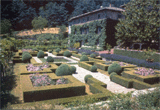| Comune: | Gaiole in Chianti |
| Sito Internet: | www.coltibuono.com |

Il monastero, fondato nel 1051, fu di proprietà dei monaci benedettini vallombrosani fino al 1810. Nel XV secolo l'abbazia del "Buon Raccolto" subì un notevole sviluppo essendo sotto il patronato di Lorenzo de'Medici. Successivamente venne trasformata in villa-fattoria mantenendo la sua funzione di presidio agricolo fino ai giorni nostri. Il giardino della Badia, restaurato radicalmente negli ultimi decenni, è impostato secondo uno schema che rispecchia quello dell'antico hortus conclusus spartito da geometriche di siepi di bosso con inserimenti di piante aromatiche e officinali. La vasca rettangolare posta al centro del giardino e le pavimentazioni dei sentieri sono realizzati in pietra serena. Lunghi pergolati di vite ornano alcuni dei percorsi esterni. Di fianco alla Badia si erge un bellissimo cedro del Libano alto 20 mt. e con una circonferenza del tronco di 7 mt., censito nell'elenco delle piante monumentali della Toscana del Corpo Forestale dello Stato. La proprietà è circondata da grandi boschi di abete bianco, frutto dell'opera di rimboschimento svolta dai monaci e rilanciata poi nell'Ottocento. Sotto la guida della famiglia Stucchi Prinetti, attuali proprietari, la fattoria è una azienda agricola affermata in Italia e all'estero.
This monastery, founded in 1051, was owned by the Vallumbrosan order of Benedictine monks until 1810. In the 15th century the "Buon Raccolto" Abbey was extensively developed under the patronage of Lorenzo dei Medici. It was subsequently transformed into a farmhouse-villa, and has retained its agricultural function ever since. The abbey garden, which has been radically restored in recent decades, is laid out in the form of the ancient hortus conclusus, or "enclosed garden", with geometrical box hedge divisions around beds planted with aromatic and medicinal plants. The rectangular pool at the centre of the garden and the paving flags are serena stone. Some of the outer walks are adorned with long pergolas draped with vines. The impressive Lebanon cedar that stands next to the abbey is 20 metres tall and has a trunk with a circumference of 7 metres; it figures in the Italian Forestry Commission's census of monumental trees of Tuscany. The property is surrounded by large white fir trees, the result of reforestation work done by the monks, which was then continued in the 19th century. Under the guidance of the Stucchi Prinetti family, the current owners, the farm is now a successful agricultural concern, widely acclaimed in Italy and abroad.
This monastery, founded in 1051, was owned by the Vallumbrosan order of Benedictine monks until 1810. In the 15th century the "Buon Raccolto" Abbey was extensively developed under the patronage of Lorenzo dei Medici. It was subsequently transformed into a farmhouse-villa, and has retained its agricultural function ever since. The abbey garden, which has been radically restored in recent decades, is laid out in the form of the ancient hortus conclusus, or "enclosed garden", with geometrical box hedge divisions around beds planted with aromatic and medicinal plants. The rectangular pool at the centre of the garden and the paving flags are serena stone. Some of the outer walks are adorned with long pergolas draped with vines. The impressive Lebanon cedar that stands next to the abbey is 20 metres tall and has a trunk with a circumference of 7 metres; it figures in the Italian Forestry Commission's census of monumental trees of Tuscany. The property is surrounded by large white fir trees, the result of reforestation work done by the monks, which was then continued in the 19th century. Under the guidance of the Stucchi Prinetti family, the current owners, the farm is now a successful agricultural concern, widely acclaimed in Italy and abroad.

